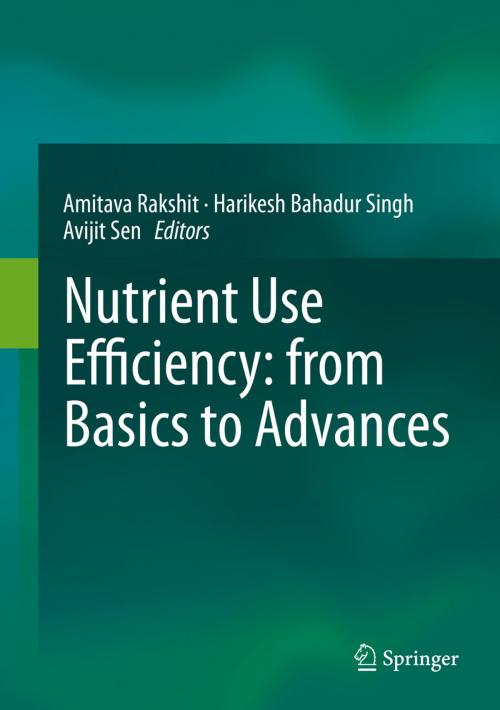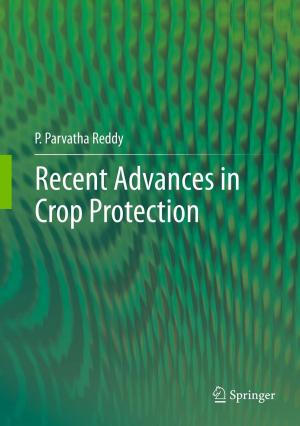Nutrient Use Efficiency: from Basics to Advances
Nonfiction, Science & Nature, Technology, Agriculture & Animal Husbandry, Nature, Environment, Environmental Conservation & Protection| Author: | ISBN: | 9788132221692 | |
| Publisher: | Springer India | Publication: | December 26, 2014 |
| Imprint: | Springer | Language: | English |
| Author: | |
| ISBN: | 9788132221692 |
| Publisher: | Springer India |
| Publication: | December 26, 2014 |
| Imprint: | Springer |
| Language: | English |
This book addresses in detail multifaceted approaches to boosting nutrient use efficiency (NUE) that are modified by plant interactions with environmental variables and combine physiological, microbial, biotechnological and agronomic aspects. Conveying an in-depth understanding of the topic will spark the development of new cultivars and strains to induce NUE, coupled with best management practices that will immensely benefit agricultural systems, safeguarding their soil, water, and air quality. Written by recognized experts in the field, the book is intended to provide students, scientists and policymakers with essential insights into holistic approaches to NUE, as well as an overview of some successful case studies. In the present understanding of agriculture, NUE represents a question of process optimization in response to the increasing fragility of our natural resources base and threats to food grain security across the globe. Further improving nutrient use efficiency is a prerequisite to reducing production costs, expanding crop acreage into non-competitive marginal lands with low nutrient resources, and preventing environmental contamination. The nutrients most commonly limiting plant growth are N, P, K, S and micronutrients like Fe, Zn, B and Mo. NUE depends on the ability to efficiently take up the nutrient from the soil, but also on transport, storage, mobilization, usage within the plant and the environment. A number of approaches can help us to understand NUE as a whole. One involves adopting best crop management practices that take into account root-induced rhizosphere processes, which play a pivotal role in controlling nutrient dynamics in the soil-plant-atmosphere continuum. New technologies, from basic tools like leaf color charts to sophisticated sensor-based systems and laser land leveling, can reduce the dependency on laboratory assistance and manual labor. Another approach concerns the development of crop plants through genetic manipulations that allow them to take up and assimilate nutrients more efficiently, as well as identifying processes of plant responses to nutrient deficiency stress and exploring natural genetic variation. Though only recently introduced, the ability of microbial inoculants to induce NUE is gaining in importance, as the loss, immobilization, release and availability of nutrients are mediated by soil microbial processes.
This book addresses in detail multifaceted approaches to boosting nutrient use efficiency (NUE) that are modified by plant interactions with environmental variables and combine physiological, microbial, biotechnological and agronomic aspects. Conveying an in-depth understanding of the topic will spark the development of new cultivars and strains to induce NUE, coupled with best management practices that will immensely benefit agricultural systems, safeguarding their soil, water, and air quality. Written by recognized experts in the field, the book is intended to provide students, scientists and policymakers with essential insights into holistic approaches to NUE, as well as an overview of some successful case studies. In the present understanding of agriculture, NUE represents a question of process optimization in response to the increasing fragility of our natural resources base and threats to food grain security across the globe. Further improving nutrient use efficiency is a prerequisite to reducing production costs, expanding crop acreage into non-competitive marginal lands with low nutrient resources, and preventing environmental contamination. The nutrients most commonly limiting plant growth are N, P, K, S and micronutrients like Fe, Zn, B and Mo. NUE depends on the ability to efficiently take up the nutrient from the soil, but also on transport, storage, mobilization, usage within the plant and the environment. A number of approaches can help us to understand NUE as a whole. One involves adopting best crop management practices that take into account root-induced rhizosphere processes, which play a pivotal role in controlling nutrient dynamics in the soil-plant-atmosphere continuum. New technologies, from basic tools like leaf color charts to sophisticated sensor-based systems and laser land leveling, can reduce the dependency on laboratory assistance and manual labor. Another approach concerns the development of crop plants through genetic manipulations that allow them to take up and assimilate nutrients more efficiently, as well as identifying processes of plant responses to nutrient deficiency stress and exploring natural genetic variation. Though only recently introduced, the ability of microbial inoculants to induce NUE is gaining in importance, as the loss, immobilization, release and availability of nutrients are mediated by soil microbial processes.















